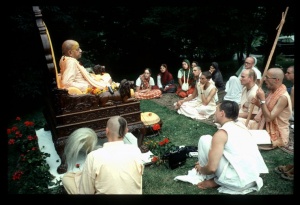CC Adi 13.90 (1975): Difference between revisions
(Vanibot #0027: CCMirror - Mirror CC's 1996 edition to form a basis for 1975) |
(Vanibot #0020: VersionCompareLinker - added a link to the Version Compare feature) |
||
| Line 2: | Line 2: | ||
<div style="float:left">'''[[Sri Caitanya-caritamrta (1975)|Śrī Caitanya-caritāmṛta (1975)]] - [[CC Adi (1975)|Ādi-līlā]] - [[CC Adi 13 (1975)|Chapter 13: The Advent of Lord Śrī Caitanya Mahāprabhu]]'''</div> | <div style="float:left">'''[[Sri Caitanya-caritamrta (1975)|Śrī Caitanya-caritāmṛta (1975)]] - [[CC Adi (1975)|Ādi-līlā]] - [[CC Adi 13 (1975)|Chapter 13: The Advent of Lord Śrī Caitanya Mahāprabhu]]'''</div> | ||
<div style="float:right">[[File:Go-previous.png|link=CC Adi 13.89 (1975)|Ādi-līlā 13.89]] '''[[CC Adi 13.89 (1975)|Ādi-līlā 13.89]] - [[CC Adi 13.91 (1975)|Ādi-līlā 13.91]]''' [[File:Go-next.png|link=CC Adi 13.91 (1975)|Ādi-līlā 13.91]]</div> | <div style="float:right">[[File:Go-previous.png|link=CC Adi 13.89 (1975)|Ādi-līlā 13.89]] '''[[CC Adi 13.89 (1975)|Ādi-līlā 13.89]] - [[CC Adi 13.91 (1975)|Ādi-līlā 13.91]]''' [[File:Go-next.png|link=CC Adi 13.91 (1975)|Ādi-līlā 13.91]]</div> | ||
{{CompareVersions|CC|Adi 13.90|CC 1975|CC 1996}} | |||
{{RandomImage}} | {{RandomImage}} | ||
==== TEXT 90 ==== | ==== TEXT 90 ==== | ||
| Line 18: | Line 17: | ||
<div class="synonyms"> | <div class="synonyms"> | ||
siṁha—the lion; rāśi—sign of the zodiac; siṁha—the lion; lagna—birth moment; ucca—high; graha-gaṇa—all planets; ṣaṭ-varga—six | siṁha—the lion; rāśi—sign of the zodiac; siṁha—the lion; lagna—birth moment; ucca—high; graha-gaṇa—all planets; ṣaṭ-varga—six area; aṣṭa-varga—eight area; sarva—all; su-lakṣaṇa—auspiciousness. | ||
</div> | </div> | ||
| Line 25: | Line 24: | ||
<div class="translation"> | <div class="translation"> | ||
According to the Jyotir-veda, or Vedic astronomy, when the figure of the lion appears both in the zodiac and the time of birth [lagna], this indicates a very high conjunction of planets, an area under the influence of ṣaḍ-varga and aṣṭa-varga, which are all-auspicious moments. | |||
</div> | </div> | ||
| Line 32: | Line 31: | ||
<div class="purport"> | <div class="purport"> | ||
The divisions of the ṣaḍ-varga area are technically called kṣetra, horā, drekkāṇa, navāṁśa, dvādaśāṁśa and triṁśāṁśa. According to Jyotir-vedic astrology, when it is calculated who rules the constellation of six areas, the auspicious moment is calculated. Śrīla Bhaktisiddhānta Sarasvatī Ṭhākura, who was previously also a great astrologer, says that in the book named Bṛhaj-jātaka and other books there are directions for knowing the movements of the stars and planets. One who knows the process of drawing a straight line and thus understands the area of aṣṭa-varga can explain the auspicious constellations. This science is known especially by persons who are called horā-śāstra-vit, or those who know the scripture of the name Horā. On the strength of astrological calculations from the Horā scripture, Nīlāmbara Cakravartī, the grandfather of Śrī Caitanya Mahāprabhu, ascertained the auspicious moment in which the Lord would appear. | |||
</div> | </div> | ||
Latest revision as of 15:13, 26 January 2020

A.C. Bhaktivedanta Swami Prabhupada
TEXT 90
- siṁha-rāśi, siṁha-lagna, ucca graha-gaṇa
- ṣaḍ-varga, aṣṭa-varga, sarva sulakṣaṇa
SYNONYMS
siṁha—the lion; rāśi—sign of the zodiac; siṁha—the lion; lagna—birth moment; ucca—high; graha-gaṇa—all planets; ṣaṭ-varga—six area; aṣṭa-varga—eight area; sarva—all; su-lakṣaṇa—auspiciousness.
TRANSLATION
According to the Jyotir-veda, or Vedic astronomy, when the figure of the lion appears both in the zodiac and the time of birth [lagna], this indicates a very high conjunction of planets, an area under the influence of ṣaḍ-varga and aṣṭa-varga, which are all-auspicious moments.
PURPORT
The divisions of the ṣaḍ-varga area are technically called kṣetra, horā, drekkāṇa, navāṁśa, dvādaśāṁśa and triṁśāṁśa. According to Jyotir-vedic astrology, when it is calculated who rules the constellation of six areas, the auspicious moment is calculated. Śrīla Bhaktisiddhānta Sarasvatī Ṭhākura, who was previously also a great astrologer, says that in the book named Bṛhaj-jātaka and other books there are directions for knowing the movements of the stars and planets. One who knows the process of drawing a straight line and thus understands the area of aṣṭa-varga can explain the auspicious constellations. This science is known especially by persons who are called horā-śāstra-vit, or those who know the scripture of the name Horā. On the strength of astrological calculations from the Horā scripture, Nīlāmbara Cakravartī, the grandfather of Śrī Caitanya Mahāprabhu, ascertained the auspicious moment in which the Lord would appear.